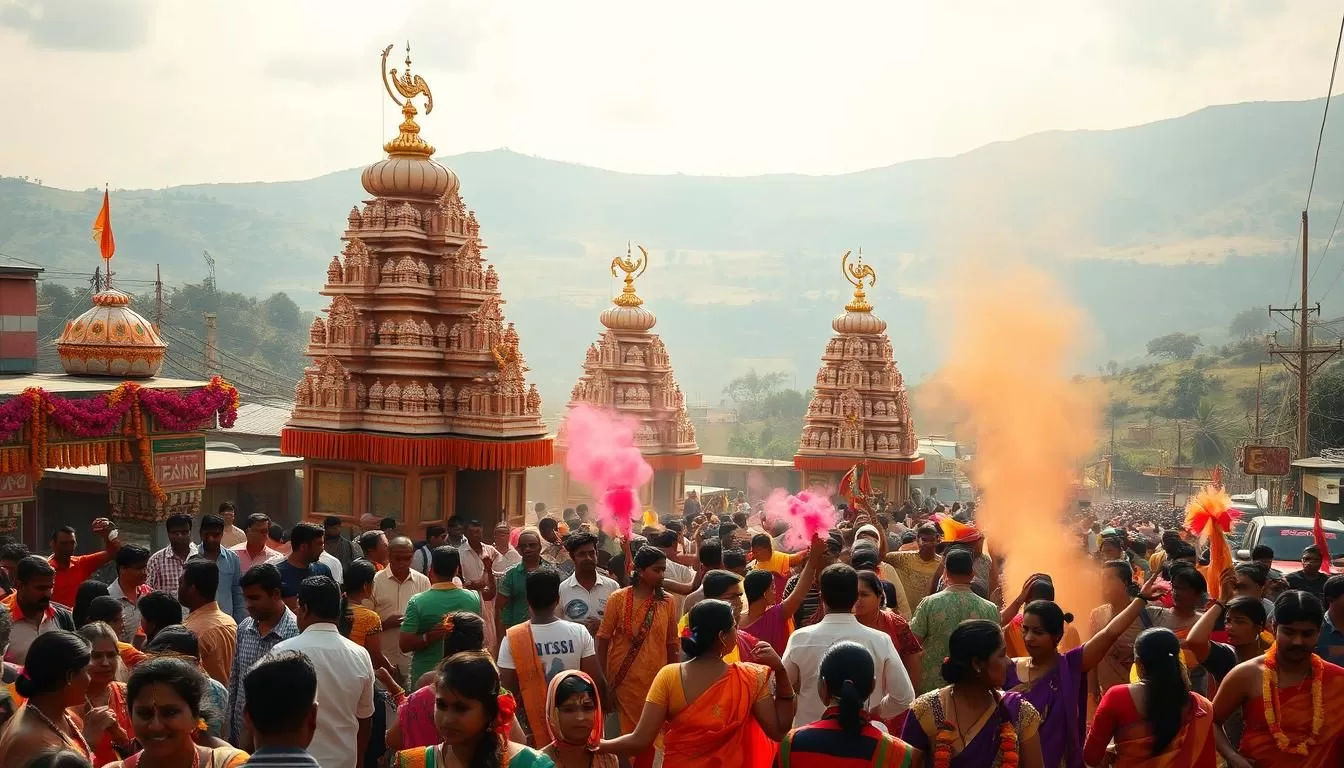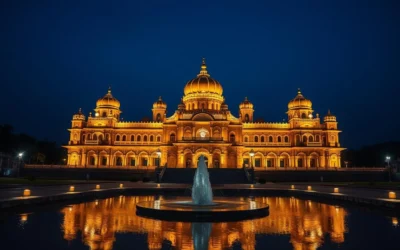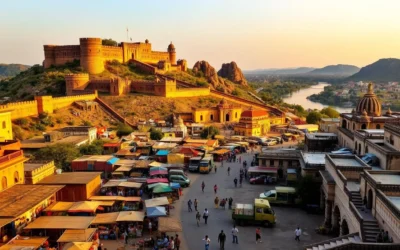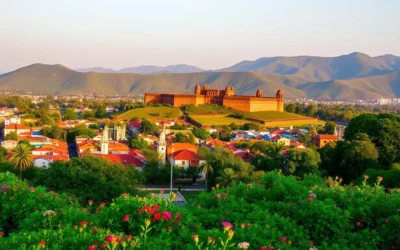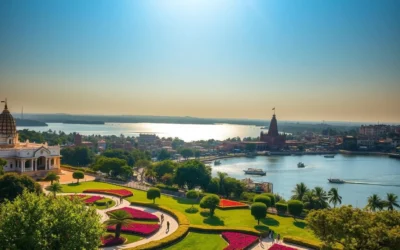✓ Accommodations✓ Flights✓ Rental Cars✓ Tours & Activities
When you visit this beautiful state, you’ll be immersed in a world of diverse celebrations that showcase its rich cultural heritage.
The festivals of Karnataka are a reflection of its history, traditions, and the coming together of different communities.
You’ll experience authentic celebrations throughout the year, ranging from religious ceremonies to harvest festivals and artistic showcases, giving you a glimpse into the region’s unique cultural identity.
By planning your visit around these celebrations, you’ll witness Karnataka at its most vibrant and festive, making your travel experience even more memorable.
Experiencing Karnataka’s Cultural Heritage Through Festivals
As you immerse yourself in Karnataka’s festivals, you’ll uncover the depth of its cultural traditions. Karnataka is a state with a rich cultural heritage, boasting numerous UNESCO-recognized sites. The state’s diverse festivals and festival celebrations offer a unique insight into its culture and traditions.
Karnataka’s festival calendar is packed with events that showcase its vibrant cultural landscape. Each festival is a reflection of the state’s history, customs, and beliefs. You’ll discover how these festivals serve as living museums, preserving the state’s cultural heritage.
| Aspect | Description | Significance |
|---|---|---|
| Cultural Traditions | Unique insights into local customs and beliefs | Preserves heritage |
| Communal Aspect | People from different backgrounds participate together | Strengthens social bonds |
| Temples and Historical Sites | Often serve as the backdrop for celebrations | Adds architectural dimension |
| Seasonal Nature | Many celebrations coincide with harvest times or seasonal changes | Reflects agricultural heritage |
By participating in these festival celebrations, you’ll experience Karnataka’s culture firsthand. It’s a chance to connect with locals and understand the significance of each celebration. The day of the festival is a moment of joy, bringing people together in festivities that are an integral part of Karnataka’s identity.

Mysore Dasara: The Royal Festival
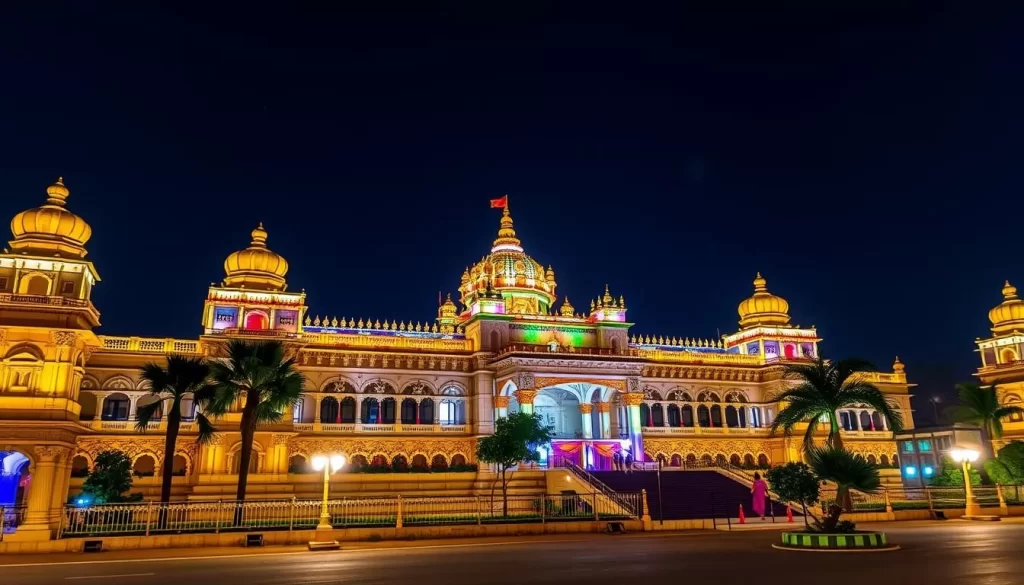
As one of Karnataka’s most revered festivals, Mysore Dasara is a dazzling display of culture, history, and spirituality. You will experience the rich heritage of Karnataka through this 10-day celebration.
The Mysore Dasara festival has its roots in the 15th century, initiated by the kings of the Vijayanagara empire. It commemorates the victory of Goddess Chamundeshwari over the demon Mahishasura, symbolizing the triumph of good over evil. This historical significance is still celebrated today, making it a unique experience for visitors.
During the festival, the city of Mysore is transformed, with the Mysore Palace being one of the main attractions. Adorned with over 10,000 light bulbs, the palace is a breathtaking sight. You can witness the grand Jumboo Savari (elephant procession) on Vijayadashami, featuring the idol of Goddess Chamundeshwari placed in a golden howdah atop an elephant.
The festival includes various cultural programs such as music concerts, dance performances, and folk art displays. You can enjoy these events throughout the city, immersing yourself in the local culture.
To make the most of your visit, here are some practical tips: plan your viewing spots for the procession in advance, visit the illuminated palace during the evening, and be prepared for the crowds. With these tips, you will have a memorable experience during the Mysore Dasara celebration.
Kambala: The Traditional Buffalo Race
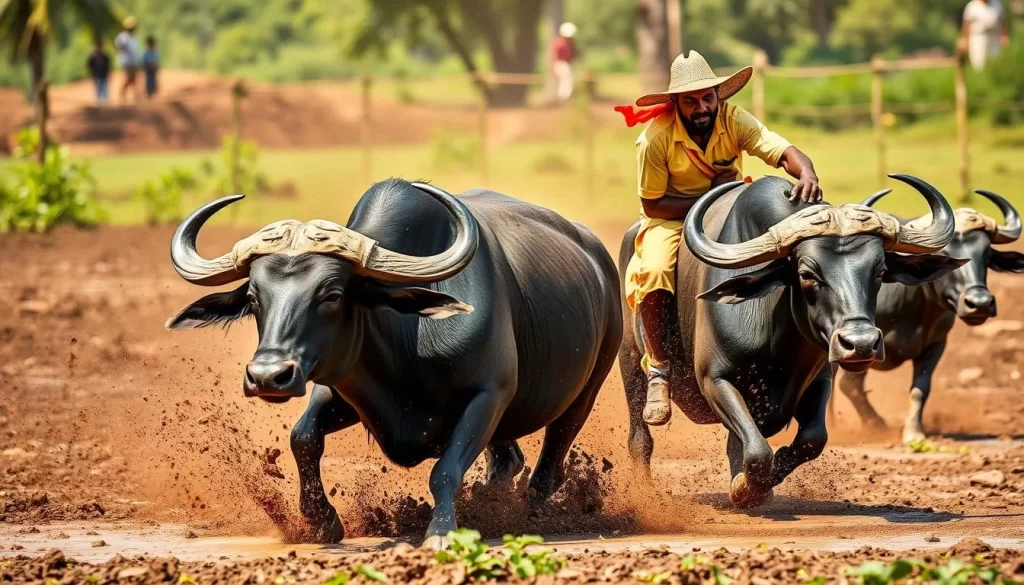
Dive into the world of Kambala, where tradition meets adrenaline in Karnataka’s coastal regions. The Kambala festival is a traditional buffalo race that has been an integral part of Karnataka’s cultural heritage for over 1,000 years.
Celebrated annually in the Dakshin Kannada and Udupi districts between November and March, this festival is a spectacle that showcases the region’s rich agricultural traditions. More than 150 buffaloes are meticulously groomed and trained for the competition, highlighting the deep connection between the farming communities and their livestock.
The race involves pairs of buffaloes tied to ploughs, sprinting through slushy paddy fields guided by their owners. This event is not just about the thrill of the race; it’s a community gathering that strengthens bonds among farming communities and preserves agricultural traditions.
As we look at the contemporary aspects of Kambala, we also address recent controversies and efforts to maintain this tradition while addressing animal welfare concerns, ensuring that this traditional buffalo race continues to be a vibrant part of Karnataka’s cultural identity for days to come.
Hampi Festival: A Celebration of History and Arts
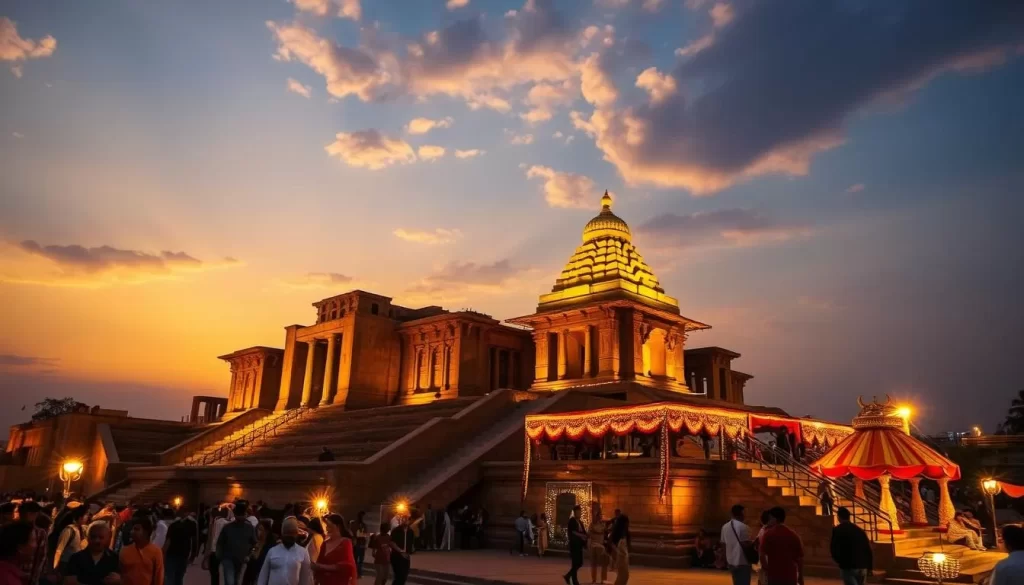
The Hampi Festival, a significant cultural event in Karnataka, is a testament to the region’s rich heritage and artistic traditions. Held annually at the Virupaksha Temple, this vibrant celebration attracts visitors from around the world.
This grand festival, also known as Vijaya Utsav, commemorates the traditions and culture of the bygone era in Hampi. The festivities, typically held in November for three days, transform the UNESCO World Heritage Site into a dynamic cultural showcase.
You’ll discover how the Hampi Festival celebrates the rich historical legacy of the Vijayanagara Empire against the dramatic backdrop of Hampi’s ancient ruins and temples. The event features diverse artistic performances, including classical dance forms and folk music concerts, particularly the popular ‘Janapada Kala Vahini’.
The festival also includes spectacular visual elements, such as the illumination of monuments throughout the 15km stretch of Hampi ruins, creating a magical atmosphere. Additionally, the “Jumbo Savari,” an elephant procession, winds through the ruins, reminiscent of royal processions from the Vijayanagara period.
The Hampi Festival not only preserves cultural heritage but also boosts tourism and provides economic opportunities for local artisans and performers. With craft bazaars and food stalls populating the festival grounds, visitors can purchase traditional handicrafts and sample local Karnataka cuisine, making it a true celebration of the region’s culture.
Pattadakal Dance Festival: Art Amidst Ancient Temples
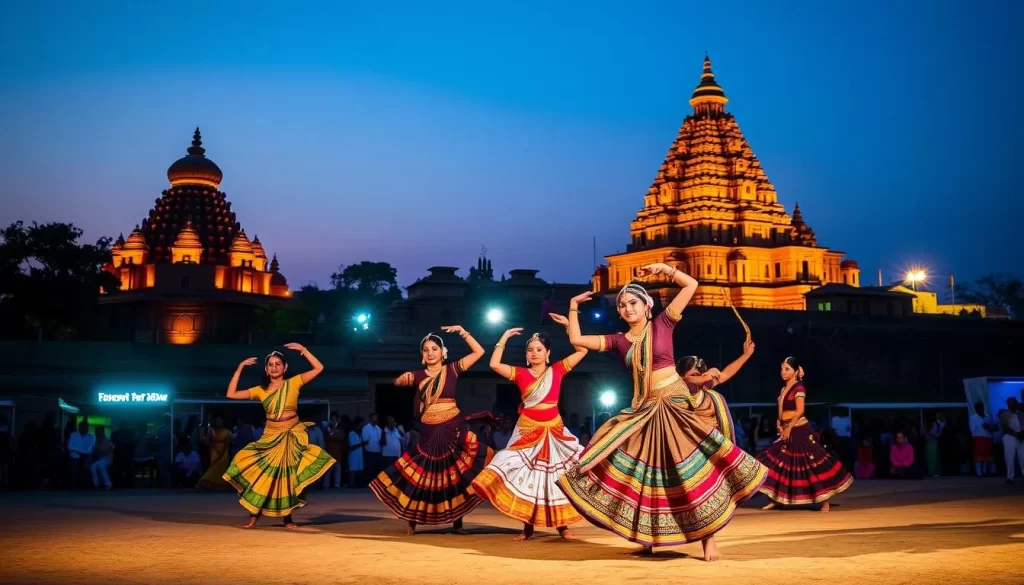
Pattadakal, a UNESCO World Heritage site, transforms into a vibrant dance festival, celebrating India’s classical dance traditions. Organized annually by the Karnataka government, this event honors the historical significance of Pattadakal’s ancient temples, mostly devoted to Shiva, with their intricate carvings.
The Pattadakal Dance Festival is a unique fusion of ancient architecture and classical performing arts. The festival grounds are set amidst the 7th and 8th-century temples, providing a stunning backdrop for performances that enhance the cultural experience.
During the festival, you can witness diverse dance forms, including Bharatanatyam, Kuchipudi, Kathak, and Odissi, performed by acclaimed artists. The event also features a craft mela where artisans display traditional handicrafts, textiles, and artwork.
The festival is not just a celebration of dance but also a promotion of the architectural heritage of Pattadakal and the rich tradition of Indian classical dance. By attending, you’ll gain insights into the historical significance of the temples and the cultural preservation efforts.
For art and dance enthusiasts, the Pattadakal Dance Festival is an event not to miss. It offers a rare opportunity to experience the beauty of classical Indian dance against the majestic backdrop of ancient temples.
Karnataka, India: Top Festivals to Check Out When Visiting Based on Seasons
As you plan your visit to Karnataka, India, you’ll find that the state’s festivals are as diverse as its landscapes, changing with the seasons. The state’s rich cultural heritage is showcased through various celebrations throughout the year, each tied to agricultural cycles, religious calendars, and historical events.
![]()
Winter Festivals (December-February)
Winter in Karnataka is marked by significant festivals like Makar Sankranti, a harvest festival celebrated in January, and the Pattadakal Dance Festival. Although Mahamastakabhisheka is a rare occurrence, happening every 12 years, it’s an event to look forward to, with the next one scheduled for 2030.
Spring Festivals (March-May)
Spring brings vibrant festivals such as Ugadi, the Kannada New Year, the Karaga Festival in Bangalore, and the Vairamudi Festival in Melukote, where the deity is adorned with a special diamond crown. These celebrations highlight the state’s cultural diversity.
Monsoon Festivals (June-August)
During the monsoon season, festivals like Vara Mahalakshmi Pooja bring color and devotion. Early preparations for Ganesh Chaturthi also begin during this time, showcasing the religious fervor of the state.
Autumn Festivals (September-November)
Autumn is a significant season with major festivals like Mysore Dasara, Kambala buffalo races in the coastal regions, and Karnataka Rajyotsava on November 1st, celebrating the state’s formation day. These events offer a glimpse into Karnataka’s rich cultural tapestry.
By understanding the festival calendar of Karnataka, you can plan your visit to coincide with these vibrant celebrations, experiencing the state’s culture in all its glory.
Religious Festivals of Karnataka
Religious festivals in Karnataka are a testament to the state’s spiritual diversity and cultural richness. You can experience the vibrant traditions and rituals that define the state’s identity by participating in these festivals.
Ganesh Chaturthi
Ganesh Chaturthi is a significant festival in Karnataka, celebrated with great fervor over 10 days. You can witness the installation of elaborate clay idols of Lord Ganesha in homes and public spaces, accompanied by rituals like Prana Pratishtha and culminating in the Ganpati Visarjan immersion ceremony. Traditional sweets like Modakam and Karanji are prepared and offered to the deity.
Gowri Festival
The Gowri Festival is celebrated one day before Ganesh Chaturthi, where married women honor Goddess Gowri by preparing a “bagina” or offering tray with turmeric, kumkum, bangles, coconut, and other auspicious items. You can learn about the significance of this festival, which is believed to mark Goddess Gowri’s visit to her parental home, followed by Lord Ganesha who comes to take her back the next day.
Mahamastakabhisheka
Mahamastakabhisheka is a grand Jain ceremony held once every 12 years in Shravanabelagola. You can witness the anointing of the 57-foot monolithic statue of Lord Bahubali with milk, saffron paste, sandalwood powder, and precious substances. This ceremony symbolizes detachment from worldly possessions and the path to enlightenment.
| Festival | Duration | Significance |
|---|---|---|
| Ganesh Chaturthi | 10 days | Installation of Lord Ganesha idols and rituals |
| Gowri Festival | 1 day | Honoring Goddess Gowri with offerings |
| Mahamastakabhisheka | Once every 12 years | Anointing of Lord Bahubali statue |
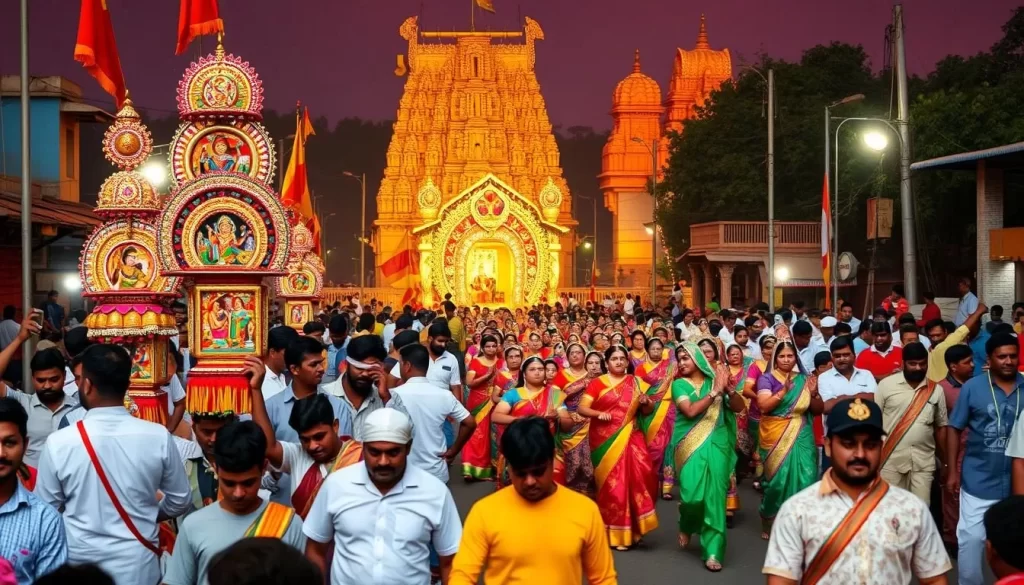
Harvest and Cultural Festivals
As you explore Karnataka, you’ll discover a tapestry of harvest and cultural festivals that are integral to the state’s identity. These celebrations not only reflect the state’s rich agricultural heritage but also its vibrant cultural diversity.
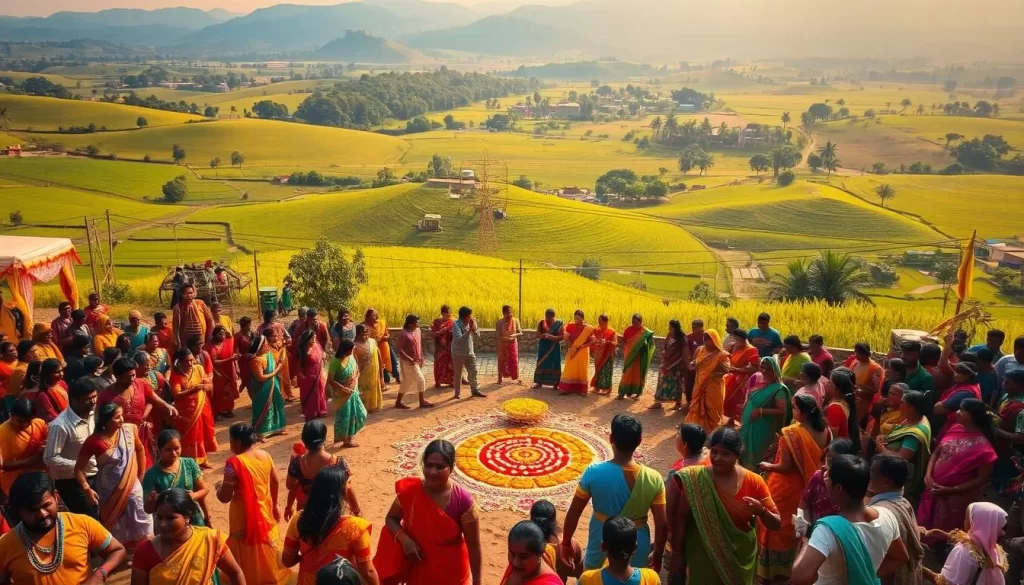
Ugadi: The Kannada New Year
Ugadi, also known as Gudi Padwa, is a significant festival in Karnataka, marking the beginning of the Kannada New Year. It’s celebrated with great fervor, typically in March or April. Homes are decorated with mango leaves and rangoli patterns, symbolizing new beginnings. Families come together to prepare the symbolic bevu-bella mixture, representing life’s sweet and bitter experiences. The traditional Ugadi feast includes special dishes like holige (sweet flatbread) and hesaru bele payasa (moong dal sweet). The reading of the Panchanga (Hindu almanac) is also a crucial part of the celebrations, predicting the coming year’s events.
Tula Sankramana
Tula Sankramana is an important harvest festival celebrated especially in the Coorg (Kodagu) district. It marks the sun’s entry into Libra and the completion of the rice harvest season. The festival involves the worship of agricultural implements, cattle, and the river goddess Cauvery. Thousands gather at Talacauvery, the source of the Cauvery River, to witness the miraculous rise in water levels. This festival is a celebration of the rice fields and the agricultural bounty of the region.
Karnataka Rajyotsava
Karnataka Rajyotsava, celebrated on November 1st, commemorates the formation of Karnataka state in 1956. It’s a day of great patriotic fervor, with the state flag being hoisted across the state. Cultural performances showcasing Karnataka’s diverse traditions are held, and the prestigious Rajyotsava Awards are presented to individuals who have contributed significantly to the state’s development. On this day, people wear new clothes and participate in the festivities, celebrating the state’s rich cultural heritage.
These festivals – Ugadi, Tula Sankramana, and Karnataka Rajyotsava – represent different aspects of Karnataka’s identity, from its agricultural heritage to its cultural calendar and political formation. They offer a comprehensive view of what makes Karnataka unique and are worth experiencing during your visit.
- Ugadi marks new beginnings with traditional feasts and decorations.
- Tula Sankramana celebrates the harvest season with unique rituals.
- Karnataka Rajyotsava commemorates the state’s formation with patriotic fervor.
Lesser-Known Yet Fascinating Festivals
While many festivals in Karnataka are widely celebrated, there are several others that remain hidden gems, offering authentic cultural experiences. These lesser-known festivals provide a unique glimpse into the state’s rich cultural heritage and traditions.
Karaga Festival
The Karaga Festival is one of the oldest celebrations in Bangalore, held on a full moon day. This festival celebrated by the Vanniyakula Kshatriya Thigala community is a folk dance ritual dedicated to Draupadi. The festival is held at the Dharmarayaswamy temple, where a grand procession takes place. A male priest carries a flower-adorned pot, known as the karaga, on his head without touching it throughout the night-long procession.
Groundnut Festival
Celebrated annually in Bangalore, the Groundnut Festival, also known as Kadalekai Parishe, is a unique celebration. You can attend this festival at Dodda Ganesha Temple in Basavanagudi, Bangalore, where farmers bring their first harvest of groundnuts as offerings to Lord Basava. The area around the temple transforms into a vibrant marketplace selling various types of groundnuts and traditional items.
Sri Vithappa Fair
The Sri Vithappa Fair is a three-day celebration held in the month of Aswija. This fair has great religious and cultural importance, attracting a large number of visitors from across states. During the festival, a puja is held followed by a grand procession carrying Lord Vithappa’s idol in a palanquin.
These lesser-known festivals offer you a chance to experience Karnataka’s diverse traditions and community practices firsthand, away from the more commercialized celebrations.
Tips for Experiencing Karnataka’s Festivals Like a Local
To truly immerse yourself in Karnataka’s vibrant culture, understanding the local customs during festivals is essential. Many festivals involve wearing new clothes, visiting temples, and sharing special sweets.
Here are some tips to enhance your experience:
- Dress modestly and wear traditional attire if possible.
- Remove your shoes before entering temples or homes.
- Use your right hand for giving or receiving items.
| Local Customs | Description |
|---|---|
| Wearing new clothes | A sign of respect and celebration during festival days. |
| Houses decorated | Houses are often decorated with rangoli and mango leaves. |
| Sharing sweets | Special sweets like holige, modak, or payasam are prepared for certain celebrations. |
By following these tips, you can have a more authentic and enjoyable experience during Karnataka’s festivals.
Conclusion
Karnataka’s festivals offer a kaleidoscope of experiences that will leave you with lifelong memories. As you’ve seen, the state’s diverse festival celebrations provide a unique glimpse into its rich cultural heritage and traditions.
From grand state-sponsored events like Mysore Dasara to intimate community celebrations like the Groundnut Festival, you’ll experience the warmth and hospitality of Karnataka’s people, creating opportunities for meaningful connections.
By timing your visit to coincide with one or more of these festivals, you’ll transform your trip into an immersive cultural journey that engages all your senses, leaving you with a deeper appreciation of India’s cultural richness and diversity, and the special part that Karnataka’s sweets and festivities play in it, making your travel to this beautiful state and its various places truly unforgettable.
The above is subject to change.
Check back often to TRAVEL.COM for the latest travel tips and deals.
